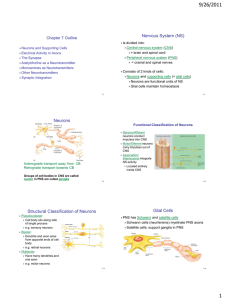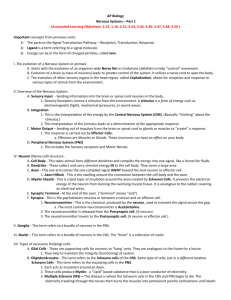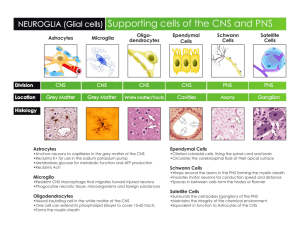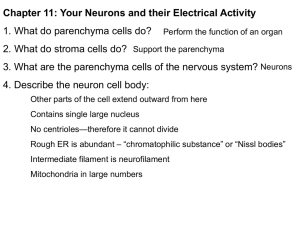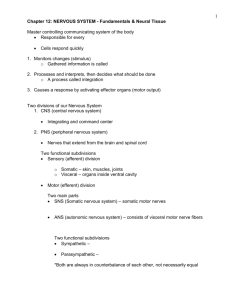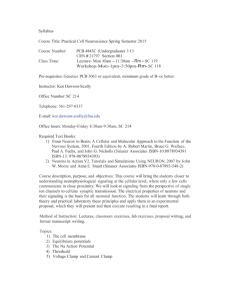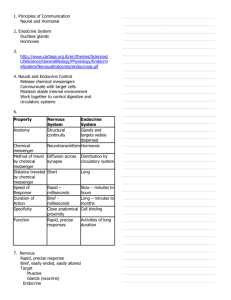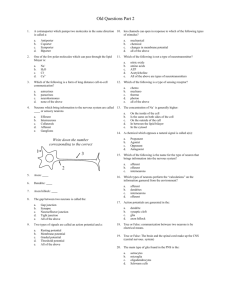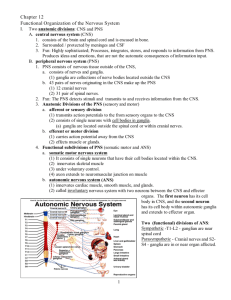The Nervous System: Neurons and Synapses
advertisement
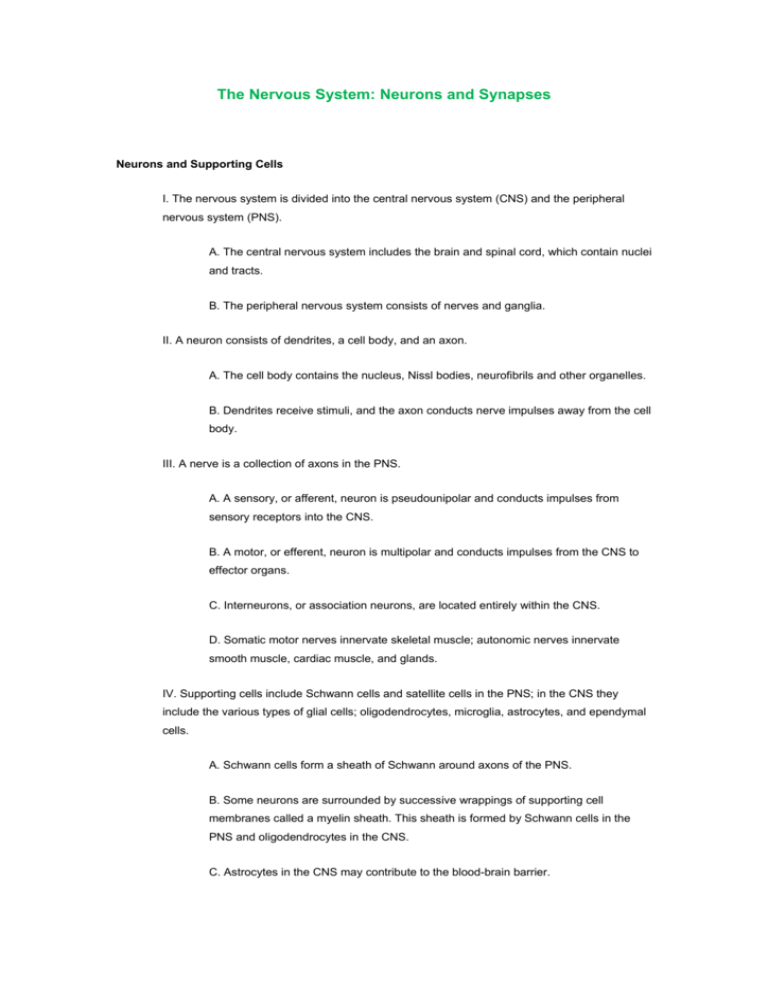
The Nervous System: Neurons and Synapses Neurons and Supporting Cells I. The nervous system is divided into the central nervous system (CNS) and the peripheral nervous system (PNS). A. The central nervous system includes the brain and spinal cord, which contain nuclei and tracts. B. The peripheral nervous system consists of nerves and ganglia. II. A neuron consists of dendrites, a cell body, and an axon. A. The cell body contains the nucleus, Nissl bodies, neurofibrils and other organelles. B. Dendrites receive stimuli, and the axon conducts nerve impulses away from the cell body. III. A nerve is a collection of axons in the PNS. A. A sensory, or afferent, neuron is pseudounipolar and conducts impulses from sensory receptors into the CNS. B. A motor, or efferent, neuron is multipolar and conducts impulses from the CNS to effector organs. C. Interneurons, or association neurons, are located entirely within the CNS. D. Somatic motor nerves innervate skeletal muscle; autonomic nerves innervate smooth muscle, cardiac muscle, and glands. IV. Supporting cells include Schwann cells and satellite cells in the PNS; in the CNS they include the various types of glial cells; oligodendrocytes, microglia, astrocytes, and ependymal cells. A. Schwann cells form a sheath of Schwann around axons of the PNS. B. Some neurons are surrounded by successive wrappings of supporting cell membranes called a myelin sheath. This sheath is formed by Schwann cells in the PNS and oligodendrocytes in the CNS. C. Astrocytes in the CNS may contribute to the blood-brain barrier. Electrical Activity in Axons I. The permeability of the axon membrane to Na+ and K+ is regulated by gates at the openings of the ion channels. A. At the resting membrane potential of -70mV, the membrane is relatively impermeable to Na+ and only slightly permeable to K+. B. The voltage-regulated Na+ and K+ gates open in response to the stimulus of depolarization. C. When the membrane is depolarized to a threshold level, the Na+ gates open first, + followed quickly by opening of the K gates. II. The opening of voltage-regulated gates produces an action potential. A. The opening of Na+ gates in response to depolarization allows Na+ to diffuse into the axon, thus further depolarizing the membrane in a positive feedback fashion. B. The inward diffusion of Na+ causes a reversal of the membrane potential from -70mV to +30 mV. C. The opening of K+ gates and outward diffusion of K+ causes the reestablishment of the resting membrane potential This is called repolarization. D. Action potentials are all-or-none events. E. The refractory periods of an axon membrane prevent action potentials from running together. F. Stronger stimuli produce action potentials with greater frequency. III. One action potential serves as the depolarization stimulus for production of the next action potential in the axon. A. In unmyelinated axons, action potentials are produced fractions of a micrometer apart. B. In myelinated axons, action potentials are produced only at the nodes of Ranvier; this saltatory conduction is faster than conduction in an unmyelinated nerve fiber. The Synapse I. Gap junctions are electrical synapses, found in cardiac muscle, smooth muscle, and some regions of the brain. II. In chemical synapses, neurotransmitters are packaged in synaptic vesicles and released by exocytosis into the synaptic cleft. A. The neurotransmitter can be called the ligand of the receptor. B. Binding of the neurotransmitter to the receptor causes the opening of chemically regulated gates of ion channels. Acetylcholine as a Neurotransmitter I. There are two different subtypes of ACh receptors: nicotinic and muscarinic. A. Nicotinic receptors enclose membrane channels and open when ACh bonds to the receptor. This causes a depolarization called an excitatory postsynaptic potential (EPSP) in skeletal muscle cells. B. The binding of ACh to muscarinic receptors opens ion channels indirectly, through the action of G-proteins. This can cause a hyperpolarization called an inhibitory postsynaptic potential (IPSP). C. After ACh acts at the synapse it is inactivated by the enzyme acetylcholinesterase (AChE). II. EPSPs are graded and capable of summation. They decrease in amplitude with distance as they are conducted. III. ACh is used in the PNS as the neurotransmitter of somatic motor neurons, which stimulate skeletal muscles to contract, and by some autonomic neurons. IV. ACh in the CNS produces EPSPs at synapses in the dendrites or cell body. These EPSPs travel to the axon hillock, stimulate opening of voltage-regulated gates, and generate action potentials in the axon. Monoamines as Neurotransmitters I. Monoamines include serotonin, dopamine, norepinephrine, and epinephrine. The last three are also included in the subcategory known as catecholamines. A. These neurotransmitters are inactivated after being released, primarily by reuptake into the presynaptic nerve endings. B. Catecholamines may activate adenylate cyclase in the postsynaptic cell, which catalyzes the formation of cyclic AMP. II. Dopaminergic neurons (those that use dopamine as a neurotransmitter) are implicated in the development of Parkinson 抯 disease and schizophrenia. Norepinephrine is used as a neurotransmitter by sympathetic neurons in the PNS and by some neurons in the CNS. Other Neurotransmitters I. The amino acids glutamate and aspartate are excitatory in the CNS. A. The subclass of glutamate receptor designated as NMDA receptors are implicated in learning and memory. B. The amino acids glycine and GABA are inhibitory. They produce hyperpolarizations, causing IPSPs, by opening Cl channels. II. There are a large number of polypeptides that function as neurotransmitters, including the endogenous opioids. III. Nitric oxide functions as both a local tissue regulator and a neurotransmitter in the PNS and CNS. It promotes smooth muscle relaxation and is implicated in memory. Synaptic Integration I. Spatial and temporal summation of EPSPs allows a sufficient depolarization to be produced to cause the stimulation of action potentials in the postsynaptic neuron. A. IPSPs and EPSPs from different synaptic inputs can summate. B. The production of IPSPs is called postsynaptic inhibition. II. Long-term potentiation is a process that improves synaptic transmission as a result of the use of the synaptic pathway. This process thus may be a mechanism for learning. (From: http://www.mhhe.com/biosci/ap/foxhumphys/student/olc/chap07summary.html)

